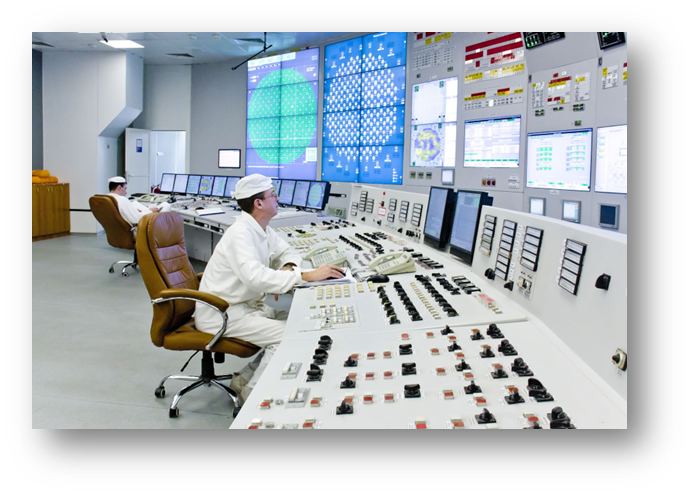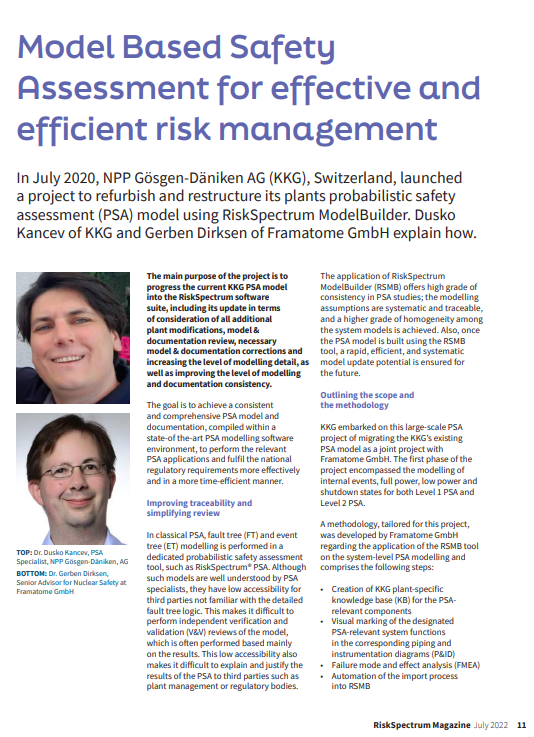SOLUTIONS
Probabilistic Safety Assessment (PSA)
RiskSpectrum is used for maintaining safe and efficient operations for operators in the most safety-critical industries of all - the nuclear industry.
You can model, analyse, monitor and manage risk with RiskSpectrum. The three main tool are, from the top down in the image to the right:
- RiskSpectrum ModelBuilder
- RiskSpectrum PSA
- RiskSpectrum RiskWatcher
RiskSpectrum ModelBuilder is used for creating a digital twin of your installation. With this information, RiskSpectrum ModelBuilder can automatically create Fault Trees for export to RiskSpectrum PSA.
In RiskSpectrum PSA you can build event trees to simulate different scenarios and connect them to the fault trees generated by RiskSpectrum ModelBuilder. RiskSpectrum PSA satisfies the nuclear industry’s requirements for PSA Level 1 and level 2. It is designed with special features to cover internal, area (fire and flooding) and external events like seismic shocks.
The complete model in RiskSpectrum PSA can now be transferred to RiskSpectrum RiskWatcher. In the RiskSpectrum RiskWatcher interface operators, planners and manager can assess risk given the current configuration and for planned configurations, e.g. outages.

Working with Large PSA Models and PSA Applications
PSA models grow in size and complexity. This can be tackled by either applying harder approximations when solving the Boolean models defined by event trees and fault trees or exploring new heuristics, exploiting specific properties of the calculations.
Click on the image to the right to open a leaflet explaning the latest development from the RiskSpectrum Team to optimise RSAT for better approximations and faster calculations in large PSA models.
In classical PSA, fault tree (FT) and event tree (ET) modelling is performed in e.g. RiskSpectrum PSA. Although such models are well understood by PSA specialists, they have low accessibility for third parties not familiar with the detailed fault tree logic.
This makes it difficult to perform independent verification and validation (V&V) reviews of the model, which is often performed based mainly on the results. This low accessibility also makes it difficult to explain and justify the results of the PSA to third parties such as plant management or regulatory bodies
The application of RiskSpectrum ModelBuilder (RSMB) offers high grade of consistency in PSA studies; the modelling assumptions are systematic and traceable, and a higher grade of homogeneity among the system models is achieved. Also, once the PSA model is built using the RSMB tool, a rapid, efficient, and systematic model update potential is ensured for the future.
Read the whole article "Model Based Safety Assessment for effective and efficient risk management" in RiskSpectrum Magazine by Dr. Dusko Kancev, PSA Specialist, NPP Gösgen-Däniken, Switzerland and Dr. Gerben Dirksen, Senior Advisor for Nuclear Safety at Framatome, Germany.
RiskWatcher Fulfill CRM Requirements in China
Regulatory requirements pertinent to Configuration Risk Management (CRM) in China is managed using RiskWatcher risk monitor at the plants.
RiskWatcher has been adapted to meet the requirements including interfaces with various plant information sources to access real-time plant statuses, triggering calculations of plant risk levels.
Click on the image on the right to open a document discussing PSA applications related to configuration risk management at the nuclear power plants in China.
Preventing trip at Qinshan Nuclear Power Plant
RiskWatcher trip monitor has been installed and implemented at 9 nuclear units at Qinshan nuclear installations. ‘Tripping’ the reactor is the terminology applied to the risk of an automatic shut-down of the plant.
The RiskWatcher trip monitor tool allows operators to:
- Assess the online risk of reactor or turbine trip (loss of production).
- Assess the offline (planning) risk of reactor or turbine trip (for assessment of maintenance and test activities).
- Identify the critical components, or so-call Single Point Vonerability (SPV), whose single failure will lead to reactor or turbine trip
- Evaluate qualitatively the status of key system/functions





